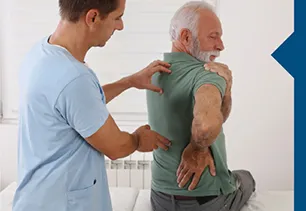Spinal stenosis is a common condition that affects many individuals, particularly as they age. It occurs when the spaces within your spine narrow, putting pressure on the spinal cord and nerves. This can result in pain, numbness, and weakness in the affected areas. While spinal stenosis can be a challenging condition to live with, physical therapy plays a crucial role in managing symptoms and improving quality of life.
In this blog post, we will explore how physical therapy can help individuals with spinal stenosis regain mobility, reduce pain, and enhance overall well-being.
UNDERSTANDING SPINAL STENOSIS
Before diving into the benefits of physical therapy, let’s briefly understand spinal stenosis.
- Lumbar Spinal Stenosis: This occurs in the lower back and is the most common type. It can result in lower back pain, leg pain, leg weakness and numbness. The symptoms can travel all the way into the feet.
- Cervical Spinal Stenosis: This affects the neck area and can result in neck pain, arm pain, arm weakness and numbness. The symptoms can travel all the way into the hands.
Symptoms can range from mild to severe, but physical therapy can be an effective non-surgical treatment option for everyone.
THE ROLE OF PHYSICAL THERAPY
Pain Management: One of the primary goals of physical therapy is to manage pain. Physical therapists use various techniques such as manual therapy which may include:
- Manual Traction: Manual traction involves gently pulling or stretching the spine to relieve pressure on the nerves and spinal cord. This can help alleviate pain and improve mobility.
- Soft Tissue Massage: Massage therapy can help relax tight muscles and reduce pain associated with spinal stenosis. It can also improve circulation and promote tissue healing.
- Myofascial Release: This technique focuses on releasing tension in the fascia, the connective tissue that surrounds muscles, by applying gentle pressure and stretching. It can improve mobility and reduce pain.
- Joint Mobilization: Joint mobilization involves passive movements of the affected joints in the spine and hips to restore range of motion and reduce pain.
- Manual Stretching: A physical therapist may use manual techniques to stretch and improve the flexibility of tight muscles and connective tissues around the spine and hips.
Strengthening Exercises: Weakness in the muscles supporting the spine and hips can exacerbate spinal stenosis symptoms. Physical therapists design customized exercise programs to strengthen these muscles, improving stability and reducing the pressure on the spine.
Stretching and Mobility Exercises: Stiffness in the spine and tightness in the surrounding muscles can contribute to spinal stenosis symptoms. Stretching and mobility exercises can help increase flexibility and improve spinal mobility making it easier to move, as well as reducing pain.
Posture and Body Mechanics: Physical therapists educate patients about proper posture and body mechanics to minimize stress on the spine. Learning how to lift, sit, and stand correctly is beneficial.
Balance and Gait Training: Spinal stenosis can affect balance and walking ability. Physical therapists work on improving balance and gait through targeted exercises, reducing the risk of falls.
Education and Lifestyle Modifications: Patients receive valuable information on managing their condition outside of therapy sessions. This includes advice on ergonomics, lifestyle modifications, and home exercises to maintain progress.
BENEFITS OF PHYSICAL THERAPY FOR SPINAL STENOSIS
- Avoiding Surgery: Many individuals with spinal stenosis can find relief through physical therapy, avoiding the need for surgery.
- Improved Mobility: Physical therapy helps restore mobility and function, allowing individuals to engage in daily activities with greater ease.
- Pain Reduction: Pain management is a significant outcome of physical therapy, enhancing the quality of life for those with spinal stenosis.
- Enhanced Posture: Correcting posture and body mechanics can prevent further spinal issues and discomfort.
- Increased Strength: Strengthening exercises can help patients regain strength and reduce the pressure on the spine.
Physical therapy is a valuable and often underutilized resource for individuals with spinal stenosis. It offers a non-invasive, personalized approach to pain management and improved function. If you or someone you know is living with spinal stenosis, consider consulting a physical therapist at Lifeline Therapy to achieve a more active and pain-free life.

